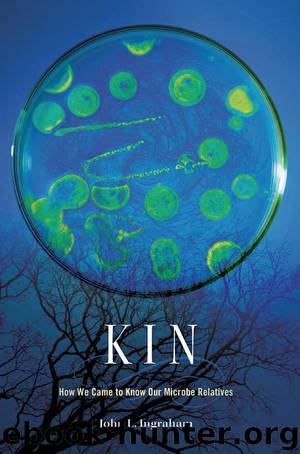Kin: How We Came to Know Our Microbe Relatives by John L. Ingraham

Author:John L. Ingraham [Ingraham, John L.]
Language: eng
Format: azw3
Publisher: Harvard University Press
Published: 2017-05-08T04:00:00+00:00
FIGURE 10. Electron micrograph of bacteriophage T4, which is almost identical in appearance to bacteriophage T2, the phage used in the Hershey and Chase experiment to prove that DNA is the genetic material. The icosahedral “head” is packed with DNA. The rest of the structure is made of protein.
The Nobel Prize committee took note of the Hershey-Chase experiment, and in 1969 Alfred Hershey shared the Nobel Prize with Max Delbrück and Salvador Luria. Neither Fredrick Griffith nor Oswald Avery, who had published the same conclusion eight years earlier, was awarded a Nobel Prize. Clearly, being a shy, soft-spoken, medical microbiologist doesn’t pay.
Although Griffith’s studies are best remembered for having led to the momentous discovery that DNA encodes genetic information, they also constitute the first revelation that genes can be transferred horizontally as well as vertically, at least among some prokaryotes. The mechanism Griffith discovered that came to be known by the curious term transformation is one that reminds us of the way fish procreate: one prokaryotic cell releases DNA into its surroundings and another cell takes it up and integrates it into its own genome, thereby becoming genetically altered or “transformed.” (My mother used the term as a euphemism for a lady’s wig.) The status and ambiguity of the word is now augmented by its use in a completely different way—to describe the transition of a cell from a normal to a cancerous state. Yet the term is still used to describe this particular kind of horizontal gene transfer.
A cursory consideration of transformation among prokaryotes engenders images of some sort of genetic orgy: genes being indiscriminately spewed from some cells and randomly taken up by others, but such is certainly not the case. Transformation as it occurs naturally among prokaryotes is a highly ordered, genetically controlled process. Only a minority of prokaryotes are capable of this type of genetic exchange, and those that are follow a tightly scripted scenario. Even in species such as the pneumococcus (Streptococcus pneumoniae), which as Griffith had discovered readily undergo transformation, cells are not always able to take up DNA from their environment. They must first enter a susceptible physiological state called competence. The process of becoming competent and successfully taking up DNA from their environment is under strict genetic oversight. In excess of twenty genes of the pneumococcus are dedicated to the processes of becoming competent and undergoing transformation.
Another naturally transformable bacterium, Haemophilus influenzae, is even more restrictive. Not only must it become competent to be transformed, the right kind of DNA must be available in its environment. H. influenzae takes up only DNA that has been released by other H. influenzae cells. It recognizes this DNA as coming from a fellow H. influenzae cell by the presence of stretches of specific ten-base pair sequences that are scattered throughout all H. influenzae DNA. At least in some cases, the release of DNA from donor cells is also regulated: evidence suggests that cells of the naturally transformable species Pseudomonas stutzeri release DNA into their surroundings only when they come in physical contact with another P.
Download
This site does not store any files on its server. We only index and link to content provided by other sites. Please contact the content providers to delete copyright contents if any and email us, we'll remove relevant links or contents immediately.
Sapiens: A Brief History of Humankind by Yuval Noah Harari(14252)
Sapiens by Yuval Noah Harari(5294)
Pale Blue Dot by Carl Sagan(4912)
Homo Deus: A Brief History of Tomorrow by Yuval Noah Harari(4823)
Livewired by David Eagleman(3683)
Origin Story: A Big History of Everything by David Christian(3648)
Brief Answers to the Big Questions by Stephen Hawking(3369)
Inferior by Angela Saini(3276)
Origin Story by David Christian(3147)
Signature in the Cell: DNA and the Evidence for Intelligent Design by Stephen C. Meyer(3071)
The Gene: An Intimate History by Siddhartha Mukherjee(3047)
The Evolution of Beauty by Richard O. Prum(2938)
Aliens by Jim Al-Khalili(2787)
How The Mind Works by Steven Pinker(2729)
A Short History of Nearly Everything by Bryson Bill(2629)
Sex at Dawn: The Prehistoric Origins of Modern Sexuality by Ryan Christopher(2481)
From Bacteria to Bach and Back by Daniel C. Dennett(2444)
Endless Forms Most Beautiful by Sean B. Carroll(2431)
Who We Are and How We Got Here by David Reich(2399)
